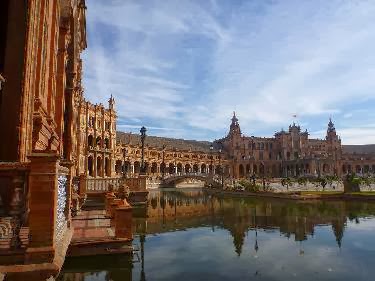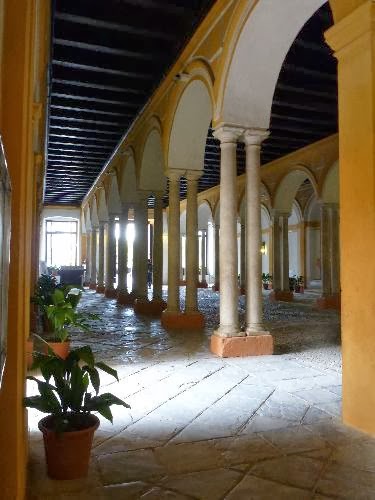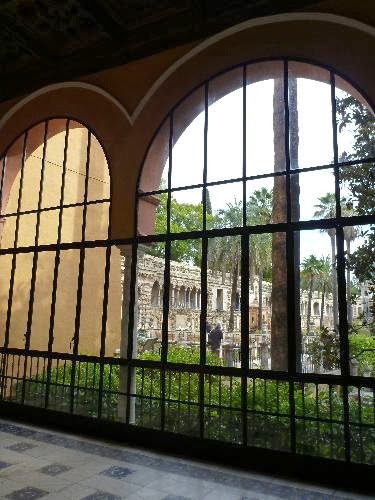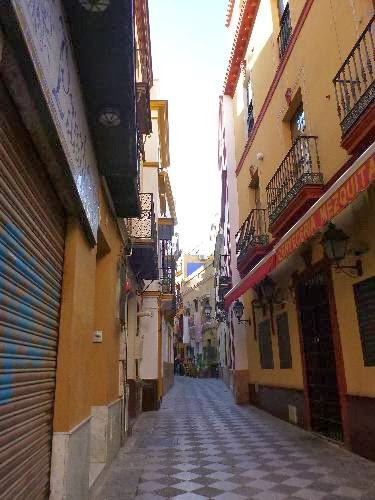We spent day 12 in Seville. We were back to hotel big breakfasts and had got more in sync with the Spanish way of doing things: get up later and go to bed later.
Our plan today was to follow the audio guide to Seville that John had downloaded for his phone. It took us along the river front towards the bull ring. Gratefully it was not bull fighting season but we were interested in seeing the ring itself. It was the size of a smallish football stadium that can seat 14,000. There was no hint of the brutality that takes place inside as we walked around the beautifully painted perimeter and past the attached buildings that look as if they serve as accommodation these days.
It was a short walk on to the Gold Tower. Originally it formed part of the city's fortifications but today it sits alone by the riverfront. We think it was called the Gold Tower because of the warmth of the stone in the sun, but there are several explanations of how it got its name. There was a display of some of the paintings in which the tower had figured in throughout history and quite a few models of ships that had docked at its door over the years. The tower now serves as the Seville Maritime Museum. Climbing to the top of the tower gave us a good viewing point along the river and across the city.
From here we headed to the magnificently ornate Plaza Espana but true to form we got distracted. We came across a huge sandstone building and I noticed people swanning in so we followed them. It turned out to be a university language department. It was great to see a magnificent building like this being used as a school rather than being set aside as a museum. Have to say I was shocked at how many of the students and teachers were smoking. I shouldn't be surprised as in a former life the building was a tobacco factory.
From here we cut across the park and unexpectedly found the Casino de Exposition de Seville. It was built for the Ibero-American Exposition of 1929. We just wanted to have a look at the building which looked ornate and magnificent but a bonus was that it was hosting a display of modern art from the Coca Cola collection.
The Plaza de España was in the Parque de María Luisa that we rode through on the bikes yesterday. It was built in 1928 for the Ibero-American Exposition of 1929. It was built in a hybrid style of Renaissance and Spanish architecture. Two enormous arms embraced a forecourt that included a pool (big enough for boats to navigate around), and there were bridges that you could use to cross the stream. The fountain was the icing on the cake in terms of opulence. There were lots of carriages bringing tourists to and fro across the enormous forecourt. The building itself was magnificently ornate with some beautiful ceramic balustrades and panels representing all the different regions of Spain. The building itself housed a series of government departments, but one part was set aside for an extensive military museum, which we visited.
We stopped for a coffee in the park and then headed to the shopping street near the cathedral. I felt like a hamburger so we stopped at Burger King. We paid for two but got given three whoppers. We tried to give the extra one away to some student types but they all declined the offer so we just left it on the table. It was a BIG meal for the middle of the day.
We had planned to see The Real (Royal) Alcázar of Seville. It was the royal palace. Originally it was a Moorish fort but successive kings and queens used it and extended it both in terms of buildings and gardens. Both John and I had no idea how amazing the building and grounds were going to be. It was built in something called the Mudejar style, which I can only call moorish. Each hall was more magnificent than the last one with finely woven ceramic tiles on the walls and floors. Each ceiling was similarly intricately carved. I will honestly have to let the photos tell the story. Each garden had its own character and inspiration but a common theme was the use of water which varies between reflective pool, fountain, fish pond and sprite (that unexpectly spurted forth as you passed through the garden rooms). There was even a fountain designed to play music as the water rushed through the pipes. There were so many familiar plants...clivias, daturas, citrus, box hedges, colocasi, ivy, jasmine, and poinsettias ( most of which we have in our Parkville garden) but the effect of the massed plantings was breathtaking. In the end we just had to stop taking photos. We honestly could have taken hundreds. What a lucky lot the Spanish royals were (and are) to have access to such a wonder.
After this we had worked up a thirst so we were looking for a place to stop at for a beer and found a great place in a plaza at the edge of the Santa Cruz district. This is one of the oldest parts of the city and is riddled by streets that dogleg their way through what was once the Jewish quarter. When Ferdinand III of Castile conquered the city from Muslim rule, he concentrated the city's Jewish into this area and then later expelled the Jews from Spain. Until recently the area was ignored and run down but it has recently become a centre for restaurants and bars. We noticed a lot of small hotels has also moved into the area. The streets of Santa Cruz were a real trap. Because of how they twist and turn we totally lost track of the direction we were heading. While we thought we were heading back to the hotel, half an hour later we realised we were heading in the opposite direction. Thank god for John and the iPad. This combination got us back to the hotel for a rest shortly after 5pm.


















































































































